Soviet Supersonic Fighter Prototypes
Lavochkin
La-190
Mikoyan-Gurevich
M-1
I-350
M-2
I-350M-2
I-350MT
Sukhoi
R
Su-17
Yakovlev
Yak-1000

Yakovlev Yak-1000
Via Eric Bond
Soviet Supersonic Fighter PrototypesLavochkinLa-190 Mikoyan-GurevichM-1 I-350M-2 I-350M-2I-350MTSukhoiR Su-17YakovlevYak-1000 |
 Yakovlev Yak-1000 Via Eric Bond |
When the first generation of jet-powered fighters was entering service in the late 1940's, the Soviets began planning for the next generation of supersonic fighters. This came forth in the form of an edict, allegedly from Joseph Stalin himself, for "the world's fastest fighter." Four aircraft designs were proposed: the Lavochkin La-190, Mikoyan-Gurevich I-350, Sukhoi Su-17 and Yakovlev Yak-1000; all utilized the Lyulka TR-3A turbojet, which was productionized as the AL-5.
The Lavochkin La-190 was a new design initiated in 1949. It featured a wing with leading-edge sweep-back of 55 degrees and integral fuel tanks. The vertical tail was swept as well, and mounted the delta-shaped horizontal tail surfaces. A nose radome was included for future installation of Torii interception radar, and two cannon were mounted in the lower nose. Landing gear was of the velosipedno tipa (bicycle type), with retractable, stabilizer outriggers under the wingtips. Only eight test flights were undertaken before the program was cancelled due to problems with the AL-5 turbojet.

The second aircraft, and probably most successful of the four, was the Mikoyan-Gurevich Izdeliya M, which received the official fighter designation of I-350. Two prototypes were planned, the M-1 (or I-350M-1) with RP-1 Izumrud radar and the M-2 (I-350M-2) with Korshun radar. Design was reminiscent of the MiG-17, with longer fuselage and new wings with a leading-edge sweep of 60 degrees. A two-seat training version, the I-350MT, was planned as well. One 37 mm and two 23 mm cannon were fitted. During the first flight of the M-1, the troublesome AL-5 turbojet failed, resulting in a loss of hydraulics as well. The pilot managed to manually extend the landing gear and land safely. Only four more test flights were made before the program was cancelled, again due to the AL-5. While the M-2 and MT variants remained unbuilt, the design was a stepping stone on the path to the MiG-19 (SM-9).
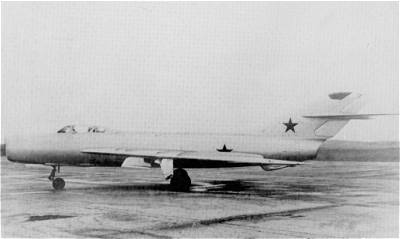
The Sukhoi R, or Su-17 (not to be confused with the later Su-17 'Fitter') also utilized a swept-wing design, being swept 55 degrees at quarter chord. Basic design was similar to the later MiG I-350. The aircraft was one of the first, if not the first, Soviet types to feature hydraulically-boosted control surfaces. The pilot was seated on a standard ejection seat in a pressurized cockpit. An unusual feature of the design was the jettisonable nose section, intended to safely seperate at high altitudes and speeds. Seperation was initiated automatically at 18g's or by pilot command. Once a safe altitude was reached, the pilot exited the nose and parachuted normally. The ejection seat could be used alternately. Two flying prototypes and one static test airframe were planned initially. The first prototype was nearing completion when it was determined by the CAI (Central Aerohydrodynamic Institute, or TsAGI in Russian) that the wing was weak torsionally and would experience similar flutter problems that had led to the crash of the earlier Su-15 prototype. As a result, flight clearance was refused and due to these "failures" Stalin ordered the Sukhoi OKB to be closed (it was later re-opened, however). The sole Su-17 suffered the ignominious fate of being used as a gunnery target, and the Su-17 designation was subsequently re-used for the more successful 'Fitter.'
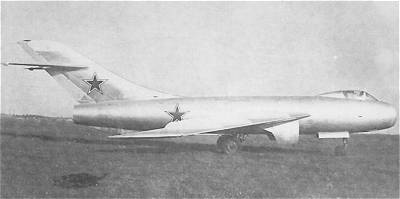
The last aircraft received the non-standard manufacturer's designation of Yak-1000, presumably signifying its goal of achieving supersonic speed (1,000 km/hr). It featured a simple cylindrical fuselage with small, mid-set delta wings and tail. Landing gear was also of the bicycle type, being based on the previous Yak-50 prototype. Unlike most installations, however, the outriggers were mounted midway instead of at the wingtips, as the tips did not afford enough chord to enclose them when retracted. The pilot was seated in a semi-reclined ejection seat to reduce frontal area. Initial ground tests revealed very poor handling, and the prototype was never flown.
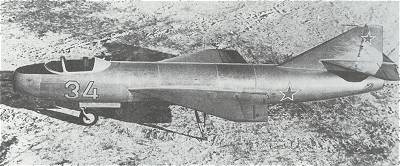
While none of these prototypes were successful, in large part due to the developmental problems experienced with the AL-5, they did advance the knowledge of Soviet aircraft designers. Had a more developed powerplant been available, it is possible that one or more would have seen service. As it was, the first supersonic fighter to enter Soviet service was the MiG-19 'Farmer' in March 1955.

Timeline

| Specifications | La-190 | I-350 | Su-17 | Yak-1000 |
| Designer(s) | ? | ? | ? | LL Selyakov |
| Mission Type | Experimental supersonic fighter, interceptor prototype | Experimental supersonic fighter, interceptor prototype | Experimental supersonic fighter, interceptor prototype | Experimental supersonic fighter, interceptor prototype |
| Powerplant | 1 x 10,140 lb (4,600 kg) s.t. Lyulka TR-3A (AL-5) turbojet | 1 x 10,140 lb (4,600 kg) s.t. Lyulka TR-3A (AL-5) turbojet | 1 x 10,140 lb (4,600 kg) s.t. Lyulka TR-3A (AL-5) turbojet | 1 x 10,140 lb (4,600 kg) s.t. Lyulka TR-3A (AL-5) turbojet |
| Dimensions | ||||
| Span | 32 ft 5.75 in (9.9 m) | 31 ft 11 in (9.73 m) | 32 ft 7.75 in (9.95 m) | 14 ft 10 in (4.52 m) |
| Length | 53 ft 7.75 in (16.35 m) | 54 ft 7.5 in (16.65 m) | 50 ft 0.375 in (15.25 m) | 38 ft 4.125 in (11.69 m) (excl. probe) |
| Height | ? | ? | ? | ? |
| Wing area | 419.05 sq ft (38.93 m2) | 387.51 sq ft (36 m2) | 296 sq ft (27.5 m2) | 150.7 sq ft (14.0 m2) |
| Weights | ||||
| Empty | 16,127 lb (7,315 kg) | 13,503 lb (6,125 kg) | 13,757 lb (6,240 kg) | ? |
| Loaded | 20,408 lb (9,257 kg) | ? | 17,394 lb (7,890 kg) | 5,512 - 5,534 lb (2,500 - 2,510 kg) |
| Max | ? | 19,202 lb (8,710 kg) | ? | ? |
| Performance | ||||
| Max speed | 739 mp @ 16,405 ft (1,190 km/hr @ 5,000 m) (Mach 1.03) | 770 mph @ sl (1,240 km/hr) (Mach 1.01) 787 mph @ 32,810 ft (1,266 km/hr @ 10,000 m) (Mach 1.175 - 1.19) |
751 mph @ sl (1,209 km/hr) (Mach 0.985) (est.) 750 mph @ 16,404 ft (1,207 km/hr @ 5,000 m) (Mach 1.05) (est.) 718 mph @ 32,808 ft (1,156 km/hr @ 10,000 m) (Mach 1.085) (est.) |
? |
| Cruise speed | -- | -- | -- | -- |
| Time to 16,405 ft (5,000 m) | 1.5 min | 1.1 min | ? | ? |
| Time to 32,810 ft (10,000 m) | ? | 2.6 min | 3.5 min (est.) | ? |
| Service ceiling | 51,180 ft (15,600 m) | 54,560 ft (16,600 m) | 47,570 ft (14,500 m) | ? |
| Range | 715 miles (1,150 km) | 696 miles (1,120 km) (internal fuel) 1,007 miles (1,620 km) (800 liter external fuel tank) |
531 - 671 miles (855 - 1,080 km) (est.) | ? |
| Armament | ||||
| Crew | One | One | One | One |
| User | USSR (not operational) | USSR (not operational) | USSR (not operational) | USSR (not operational) |
| Number built | One | I-350 (M-1): one I-350M-2: none I-350MT: none |
Two prototypes & one static test planned; first prototype almost complete | One |
| Construction Numbers | ? | ? | ? | ? |
| Serial Numbers | ? | ? | ? | ? |
| Test Pilots | Kochyetkov | Colonel Grigori A Sedov | -- | DV Zyuzin |
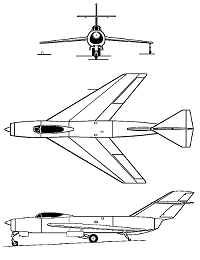 Lavochkin La-190 |
 Mikoyan-Gurevich I-350 |
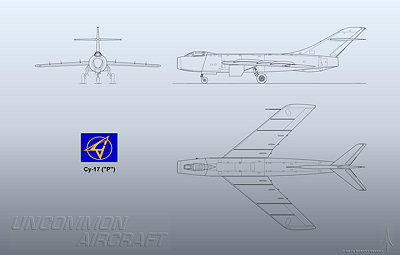 Sukhoi Su-17 |
 Yakovlev Yak-1000 |
Profiles
 Sukhoi Su-17, landing gear extended. |
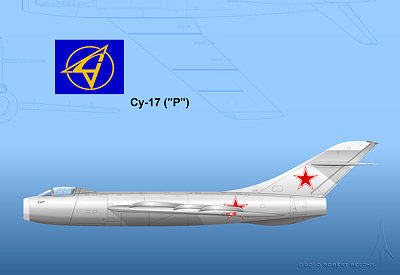 Sukhoi Su-17, landing gear retracted. |
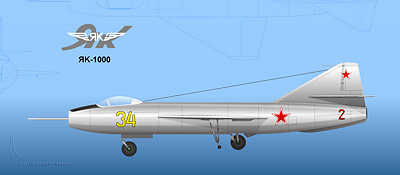 Yakovlev Yak-1000, landing gear extended. |
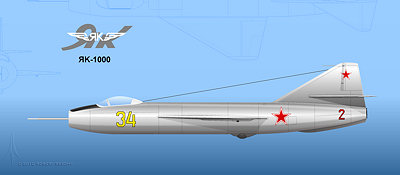 Yakovlev Yak-1000, landing gear retracted. |
Additional Information
Web Links
Sources
| [ | Home | | | About | | | Contact | | | Top | ] |
© 1997-2005, Robert Beechy
http://fire.prohosting.com/uncommon/aircraft/soviet/index.html
Originally posted 25 December 1998
Modified: 08/06/2010